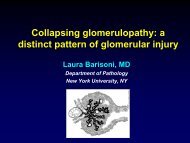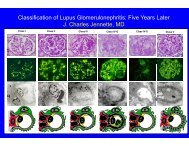An Algorithmic Approach to Renal Biopsy Interpretation of ...
An Algorithmic Approach to Renal Biopsy Interpretation of ...
An Algorithmic Approach to Renal Biopsy Interpretation of ...
You also want an ePaper? Increase the reach of your titles
YUMPU automatically turns print PDFs into web optimized ePapers that Google loves.
Table 2 continued.CrescentFibrinoid necrosisSclerosisHyalineMembranoproliferativeLobular (hypersegmented)MesangiolysisExtracapillary hypercellularity other than the epithelialhyperplasia <strong>of</strong> collapsing variant <strong>of</strong> FSGSLytic destruction <strong>of</strong> cells and matrix with deposition <strong>of</strong>acidophilic fibrin-rich materialIncreased collagenous extracellular matrix that isexpanding the mesangium, obliterating capillary lumensor forming adhesions <strong>to</strong> Bowmans capsuleGlassy acidophilic extracellular materialCombined capillary wall thickening and mesangial orendocapillary hypercellularityConsolidated expansion <strong>of</strong> segments that aredemarcated by intervening urinary spaceDetachment <strong>of</strong> the paramesangial GBM from themesangial matrix or lysis <strong>of</strong> mesangial matrixTable 3, lists the major patterns <strong>of</strong> glomerular injury that can be observed by lightmicroscopy. Note that a specific category <strong>of</strong> disease (e.g. lupus nephritis, IgA nephropathy,post-infectious glomerulonephritis) can cause more than one pattern <strong>of</strong> injury.Table 3: Patterns <strong>of</strong> glomerular injury observed by light microscopy and some but not all<strong>of</strong> the diseases that can cause each patterns <strong>of</strong> injury.No abnormality by light microscopy:1. No glomerular disease2. Glomerular disease with no light microscopic changes (e.g. minimal change glomerulopathy,thin basement membrane nephropathy)3. Mild or early glomerular disease (e.g. ISN/RPS Class I lupus nephritis, IgA nephropathy, C1qnephropathy, membranous glomerulopathy, amyloidosis, Alport syndrome, etc.)Thick capillary walls without hypercellularity or mesangial expansion:1. Membranous glomerulopathy (primary or secondary) (>Stage I)2. Thrombotic microangiopathy with expanded subendothelial zone3. Preeclampsia/eclampsia with endothelial swelling3. Fibrillary glomerulonephritis with predominance <strong>of</strong> capillary wall depositsThick walls with mesangial expansion but little or no hypercellularity:1. Diabetic glomerulosclerosis with diffuse rather than nodular sclerosis2. Secondary membranous glomerulopathy with mesangial immune deposits3. Amyloidosis4. Monoclonal immunoglobulin deposition disease5. Fibrillary glomerulonephritis6. Dense deposit disease (type II membranoproliferative glomerulonephritis)Focal segmental glomerular sclerosis without hypercellularity:1. Focal segmental glomerulosclerosis (primary or secondary)2. Chronic sclerotic phase <strong>of</strong> a focal glomerulonephritis3. Hereditary nephritis (Alport syndrome)





